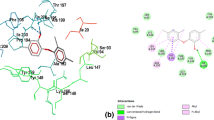Abstract
Inhibitors of 3OC12, an initial signal molecule of the quorum sensing (QS) signaling cascade in Pseudomonas aeruginosa have been developed. Eight inhibitor candidates were synthesized by substituting the head part of 3-oxododecanoyl-homoserine lactone (3OC12) with different aromatic rings, and their docking poses and scores (binding energies) were predicted by in silico modeling study. All compounds gave better docking scores than 3OC12 and good inhibition effects on LasR activity in the in vivo bioassay. Like the modifications in the tail part of 3OC12 in our previous study Kim et al. (2008), the head-part modifications also showed inhibition activity in a fairly good proportion to the docking scores from the modeling analysis. This implies that the head part of 3OC12 also contributes significantly to forming the active conformation of the LasR-3OC12 complex, and its modification could effectively induce the inactive conformation of the complex. We suggest that the head part of 3OC12 is also a good target moiety to develop the structure-based Pseudomonas QS inhibitors.







Similar content being viewed by others
References
Bhattacharyya S, Gooding OW, Labadie J (2003) Expedient synthesis of secondary amines bound to indole resin and cleavage of resin-bound urea, amide and sulfonamide under mild conditions. Tetrahedron Lett 44:6099–6102
Böhm H-J (1994) The development of a simple empirical scoring function to estimate the binding constant for a protein-ligand complex of known three-dimensional structure. J Comput-Aided Mol Design 8:243–256
Bottomley MJ, Muraglia E, Bazzo R, Carfi A (2007) Molecular insights into quorum sensing in the human pathogen Pseudomonas aeruginosa from the structure of the virulence regulator LasR bound to its autoinducer. J Biol Chem 282:13592–13600
Chugani SA, Whiteley M, Lee KM, D'Argenio D, Manoil C, Greenberg EP (2001) QscR, a modulator of quorum-sensing signal synthesis and virulence in Pseudomonas aeruginosa. Proc Natl Acad Sci 98:2752–2757
Clark M, Cramer RDIII, Van Opdenbosch NJ (1989) Validation of the general purpose Tripos 5.2 force field. Comp Chem 10:982–1012
Clay RJ, Collom TA, Karrick GL, Wemple J (1993) A safe, economical method for the preparation of β-oxo-esters. Synthesis 3:290–292
Costerton JW, Lewandowski Z, DeBeer D, Caldwell D, Korber D, James G (1994) Biofilms, the customized microniche. J Bacteriol 176:2137–2142
Daniels R, Vanderleyden J, Michiels J (2004) Quorum sensing and swarming migration in bacteria. FEMS Microbiol Reviews 28:261–289
Estep KG, Neipp CE, Stramiello LMS, Adam MD, Allen MP, Robinson S, Roskamp EJ (1998) Indole resin: A versatile new support for the solid-phase synthesis of organic molecules. J Org Chem 63:5300–5301
Fuqua C, Greenberg EP (2002) Listening in on bacteria. Acyl-homoserine lactone signaling. Nat Rev Mol Cell Biol 3:685–695
Fux CA, Costerton JW, Stewart PS, Stoodley P (2005) Survival strategies of infectious biofilms. Trends Microbiol 13(1):34–40
Geske GD, Wezeman RJ, Siegel AP, Blackwell HE (2005) Small molecule inhibitors of bacterial quorum sensing and biofilm formation. J Am Chem Soc 127:12762–12763
Jefferson KK (2004) What drives bacteria to produce a biofilm? FEMS Microbiol Lett 236:163–173
Kim C, Kim J, Park HY, McLean RJC, Kim CK, Jeon J, Yi SS, Kim YG, Lee YS, Yoon J (2007) Molecular modeling, synthesis, and screening of new bacterial quorum-sensing antagonists. J Microbiol Biotechnol 17:1598–1606
Kim C, Kim J, Park HY, Park HJ, Lee JH, Kim CK, Yoon J (2008) Furanone derivatives as quorum-sensing antagonists of Pseudomonas aeruginosa. Appl Microbiol Biotechnol 80:37–47
Ko DH, Kim DJ, Lyu CS, Min IK, Moon HS (1998) New cleavage approaches to combinatorial synthesis of homoserine lactones. Tetrahedron Lett 39:297–300
Lee JH, Lequette Y, Greenberg EP (2006) Activity of purified QscR, a Pseudomonas aeruginosa orphan quorum-sensing transcription factor. Mol Microbiol 59:602–609
Makara GM, Ma Y (2001) Michael addition of amines to vinyl sulfonamides on solid support. Tetrahedron Lett 42:4123–4125
Mannhold R, Cruciani G, Weber H, Lemoine H, Derix A, Weichel C, Clementi M (1999) 6-Substituted benzopyrans as potassium channel activators: synthesis, vasodilator properties and multivariate analysis. J Med Chem 42:981–991
Matthias R, Kramer B, Lengauer T, Klebe G (1996) A fast flexible docking method using an incremental construction algorithm. J Mol Biol 261:470–489
Miller KJ (1990) Additivity methods in molecular polarizability. J Am Chem Soc 112:8533–8542
Passador L, Cook JM, Gambello MJ, Rust L, Iglewski BH (1993) Expression of Pseudomonas aeruginosa virulence genes requires cell-to-cell communication. Science 260(5111):1127–1130
Rasmussen TB, Givskov M (2006) Quorum-sensing inhibitors as anti-pathogenic drugs. Int J Med Microbiol 296:149–161
Rumbaugh KP, Griswold JA, Hamood AN (2000) The role of quorum sensing in the in vivo virulence of Pseudomonas aeruginosa. Microbes and Infection 2:1721–1731
Schuster M, Urbanowski ML, Greenberg EP (2004) Promoter specificity in Pseudomonas aeruginosa quorum sensing revealed by DNA binding of purified LasR. Proc Natl Acad Sci USA. 101:15833–15839
Shirtliff ME, Mader JT, Camper AK (2002) Molecular interactions in biofilms. Chem Biol 9:859–871
Singh R, Paul D, Jain RK (2006) Biofilms: implications in bioremediation. Trends Microbiol 14(9):389–397
Smith KM, Bu Y, Suga H (2003) Library screening for synthetic agonists and antagonists of a Pseudomonas aeruginosa autoinducer. Chem Biol 10:563–571
Whiteley M, Lee KM, Greenberg EP (1999) Identification of genes controlled by quorum sensing in Pseudomonas aeruginosa. Proc Natl Acad Sci 96:13904–13909
Ymele-Leki P, Ross JM (2007) Erosion from Staphylococcus aureus biofilms grown under physiologically relevant fluid shear forces yields bacterial cells with reduced avidity to collagen. Appl Environ Microbiol 73(6):1834–1841
Acknowledgments
This research was partially supported by the Korea Ministry of Environment as “The Eco-technopia 21 project (102-081-067)”, the Korea Science and Engineering Foundation grant funded by the Korea government (MOST; No. R01-2007-000-20732-0), and World Class University program through the Korea science and Engineering Foundation funded by the Ministry of Education, Science, and Technology (400-2008-0230). For Joon-Hee Lee, this work was supported by a research grant for the Research Team for Longevity Life Sciences in Pusan National University.
Author information
Authors and Affiliations
Corresponding authors
Rights and permissions
About this article
Cite this article
Kim, C., Kim, J., Park, HY. et al. Structural understanding of quorum-sensing inhibitors by molecular modeling study in Pseudomonas aeruginosa . Appl Microbiol Biotechnol 83, 1095–1103 (2009). https://doi.org/10.1007/s00253-009-1954-3
Received:
Revised:
Accepted:
Published:
Issue Date:
DOI: https://doi.org/10.1007/s00253-009-1954-3




